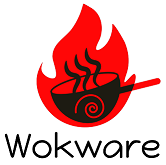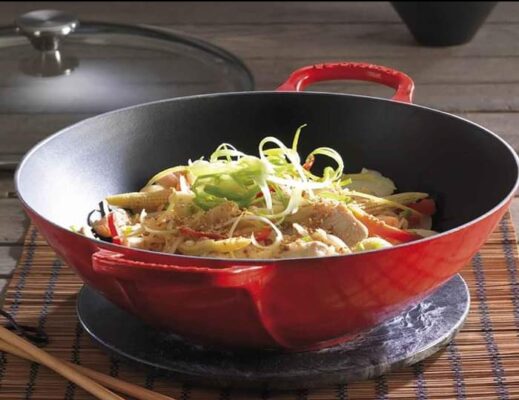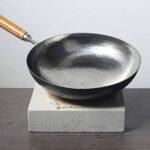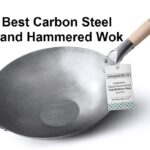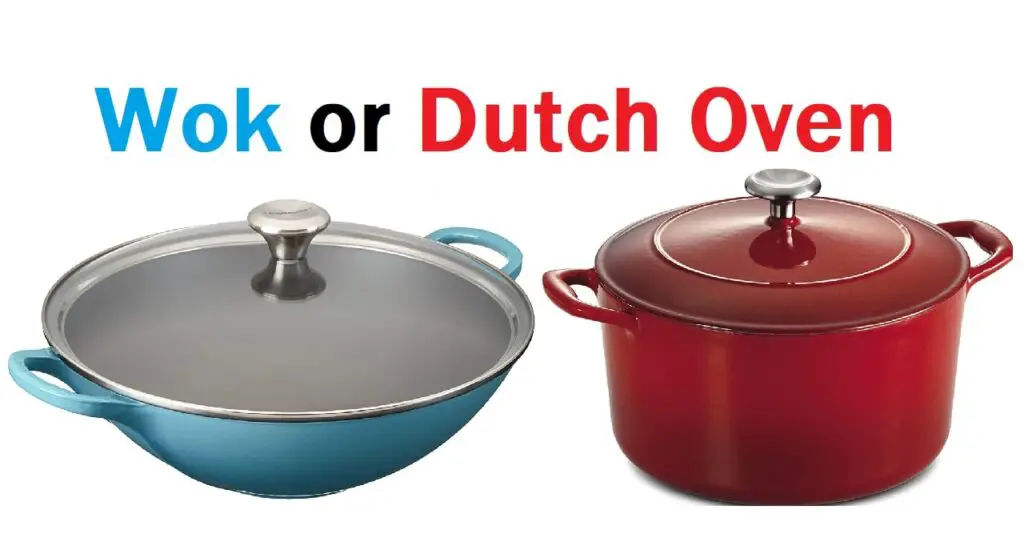
A wok pan and a dutch oven have very few similarities. However, both are useful in different ways. Here in this article, we have covered every aspect of their differences and similarities.
What is a wok?
A wok is traditionally round-bottomed (modernized in flat bottoms too) cooking pot used mostly in Asian cuisine. It is best for making delicious stir-fry on high heat. With some added wok accessories like a lid, steamer insert, wok ladle, etc, a wok can be used for almost any type of cooking technique.
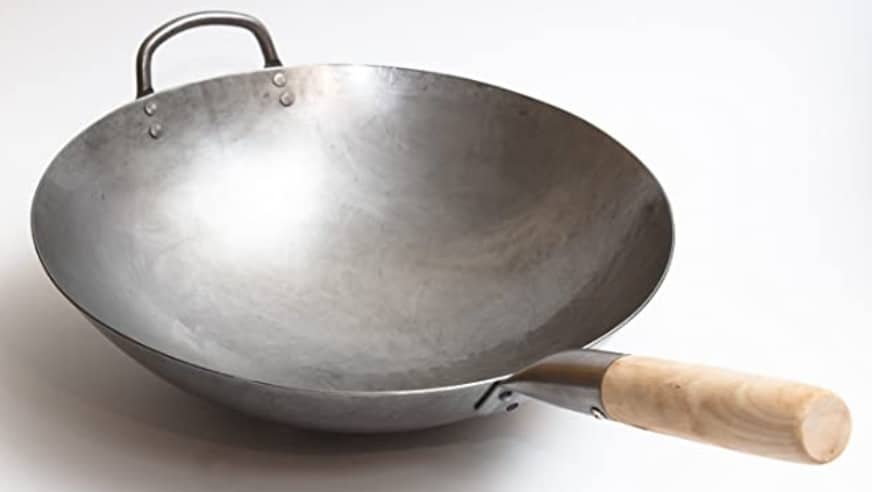
From braising, searing, boiling, deep frying to steaming, a wok gives you versatile cooking opportunities. It is common in China and other Asian countries due to the various advantages such as even heat distribution, low oil requirement, and ease of cooking.
What is a dutch oven?
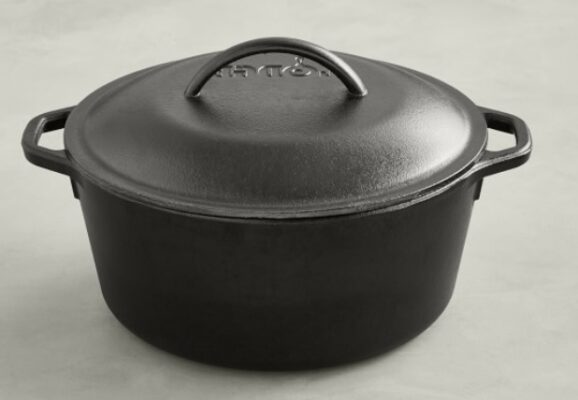
A dutch oven is a thick-walled cooking pot with a tight-filling lid, having (almost) the same diameter at the top and the bottom. They are popular for their high capacity, heat retention and are particularly good at retaining moisture and preventing drying during long cooking times.
Quick Comparison: Wok vs Dutch Oven in a Table (Read below for detailed Comparison)
| | Wok (Fast Cooking Tool) | Dutch Oven (Slow Cooking tool) |
| Usage and ease of use | >Great for Asian cuisine, mainly a stir-frying tool. >Deep-frying, braising, poaching, pan-frying, stewing etc. can be done too. >Easy to clean (if there’s non-stick coating). >Cooking is effortless due to the shape. Stir-frying is very easy comparatively and needs less oil. | >Good for pasta, stew, soup, and casserole. >Can cook anything that can be cooked in a conventional oven. >Stir-frying and deep-frying is a little difficult and needs more oil. |
| Maintenance issues | >(Woks from Rachael Ray, Cooks Standard do not have the below issues) >Can’t use a metal spatula if there’s a non-stick coating. >High heat can cause the coating to decompose. >Once the coating is gone, it might need regular seasoning. >A thorough cleaning can cause the coating to scratch. >Cast iron woks are very hard to maintain. | >In cheap Dutch ovens coatings are sometimes unsafe. >Uncoated ones need regular seasoning if not made with enameled cast iron. >For cheap coatings, high-temperature cooking can cause crazing and discoloration. >Needs you to clean gently. |
| Material | Mostly carbon steel. Cast iron, aluminum, iron, ceramic, and stainless steel woks are also available. | Mostly cast iron although others are available too. |
| Size and weight | On the lighter side due to lower capacity. It takes up the same storage space but serves fewer people. | On the heavier side due to high capacity. Same storage space but serves more people in comparison to woks. |
| Price | 14 inch standard size wok is available in all price ranges ($30 – $200 approx.) | 4 qt Dutch Oven is a bit expensive ($80 – $300 approx.) |
Usage and ease of use: Wok vs Dutch Oven
Woks are best suited for Asian cuisine, justifying the reason why they are from China. It is used in a range of cooking techniques such as stir-frying, steaming, deep-frying, poaching, braising, pan-frying, stewing, etc.

Stir-frying is particularly easier in a wok due to its shape – the ingredients will fall back to the center, the oil requirement is low, and the food tossed when stir-frying will land back to the wok. Many spicy Asian food items need stir-frying (fast cooking technique), and a Wok pan is the most suitable cooking tool for that.
Dutch ovens are suited for long, slow cooking techniques, especially for making soups, stews, bread, pasta, casserole, etc. Almost anything that can be cooked in a conventional oven can be cooked in a dutch oven too. It can also be used to deep-fry, but you’ll have to use much more oil than a wok due to its flat bottom.
For the same reason, stir-frying in a dutch oven is a little difficult. However, a wok is a versatile cooking tool, other than stir-frying, you can roast, make soup, steam, braise, deep fry, smoke, poach, and whatnot. All you need is a wok lid, and immediately it will turn into a multipurpose cooking tool.
Material: Build Quality (Wok Vs Dutch Oven)
Nowadays stainless steel woks have come into fashion. But to be honest the authentic wok cooking experience can be earned in a cast iron or carbon steel wok. The most popular woks are made of carbon steel and cast iron. It is difficult to say which one is better, even cooks tend to be divided on this matter.
But, on a general note, cast iron pans are less stick prone, retain heat, and distribute heat more evenly than carbon steel, but their response to heat adjustments is much slower. For the same reason, food prepared in cast iron cookware needs to be removed when it is ready.
But an enameled cast iron wok like the Le Creuset is the best-suited cooking tool for those who are looking for a beginner-friendly wok with durable built, safe coating, no need for seasoning, and less time to spend on cleaning and maintaining a wok.

When it comes to dutch ovens, the most popular of them are made of seasoned cast iron, while cast aluminum and ceramic dutch ovens are also available on the market. Enameled cast iron is used instead of seasoned cast iron now, which prevents rusting, eliminates the need for seasoning, and allows more thorough cleaning. One such popular enameled cast iron dutch oven is from Le Creuset that offers the best high-end and premium quality dutch oven on the market.

Maintenance: Wok Vs Dutch Oven
For woks with a non-stick coating, only wooden spatulas can be used. Using a metal spatula instead can scratch the non-stick surface. Also, if it is a Teflon coating, cooking at temperatures higher than 500°F can decompose it, making the food unhealthy. Ceramic non-stick coatings last much longer and do not have this issue.
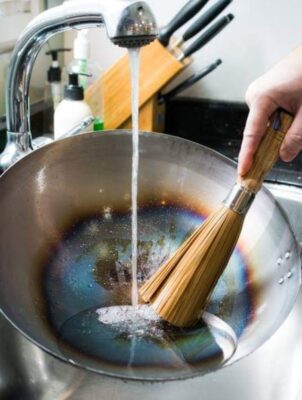
At the same time, the coating makes cleaning and cooking effortless and prevents food from sticking to the pot. A little bit of care can make your non-stick coating last longer. When the coating is gone, the wok might need regular seasoning to prevent rusting.
Woks that are made of non-coated pure cast iron, stainless steel, or carbon steel need to be seasoned properly so that the food doesn’t get stick to it. The seasoned surface will create a natural non-stick patina where your food will need less oil.
These are easy to clean too. Just use a wok bamboo brush as given in the picture to scrape out the leftover food. Here in this list of the best wok to buy you will get woks that are made of safe non-stick coating and have durable material which makes cooking fun and cleaning breeze.
Dutch ovens, if made of cast iron, needs seasoning every once in a while, to prevent rusting. If it is enameled cast iron, it does not need seasoning, but, similar to woks with non-stick coatings, cooking at high temperatures can damage the finish of the enameled cast iron. It may cause discoloration and crazing.
Size and Weight: Wok Vs Dutch Oven Comparision
Both dutch ovens and woks come in a variety of sizes and capacities, but a wok of the same size as that of a dutch oven will have much lesser capacity due to its shape. For example, if a 14-inch dutch oven has a capacity of 6 quarts, the capacity of a 14-inch wok will be only around 4 quarts since dutch ovens have a flat bottom and woks have a round bottom with curved walls.
The size and capacity matters when it comes to storage space and the number of members of the family. A 14-inch dutch oven might serve 6 to 8 people while a 14-inch wok will serve 4 to 6 people only.
On the other hand, cooking gets difficult as the size of the dutch oven increases, while the curved sides of the wok make it easier.
Coming to the weight, cast iron is heavier than carbon steel, and hence a carbon steel wok will weigh less than a cast iron dutch oven. While it totally depends on your choice of material, in the case of a dutch oven and a wok of the same diameter, the dutch oven will be heavier due to the extra capacity.
Final Thoughts:
Woks and dutch ovens are two cooking appliances used for different cooking techniques, although some kinds of cooking, like stews and soups, can be done in both of them. When you have to choose between them, what matters is your cooking habits and your maintenance and storage preferences. If you do a lot of stir-frying, or love Asian cuisine, a wok may be a good option. But if you love soups and stews, or cooks bread often, a dutch oven might be the right choice.
Happy cooking!
